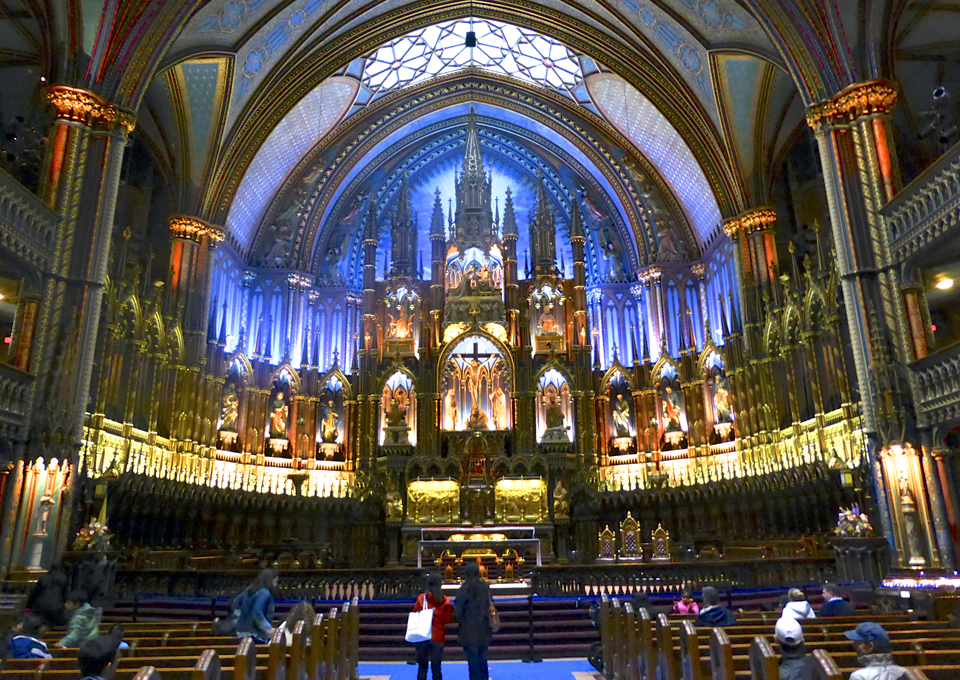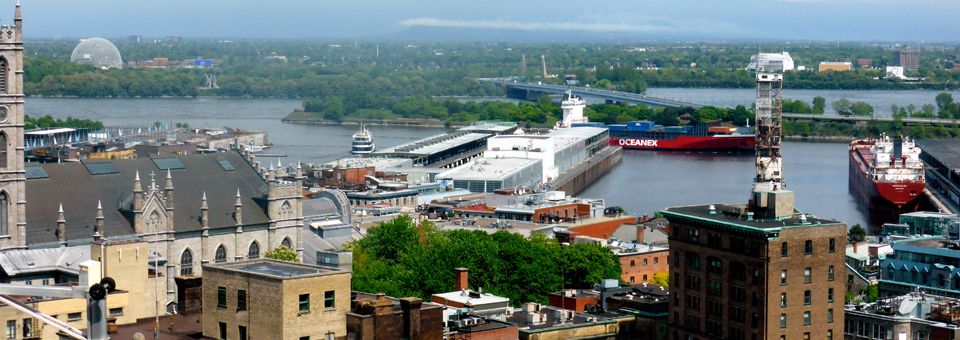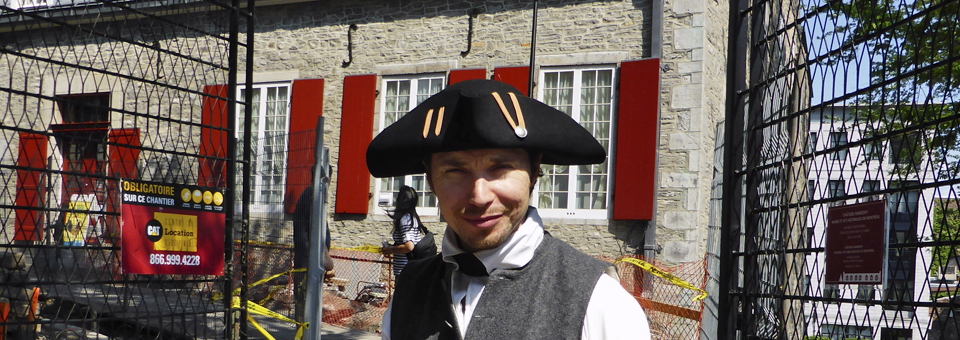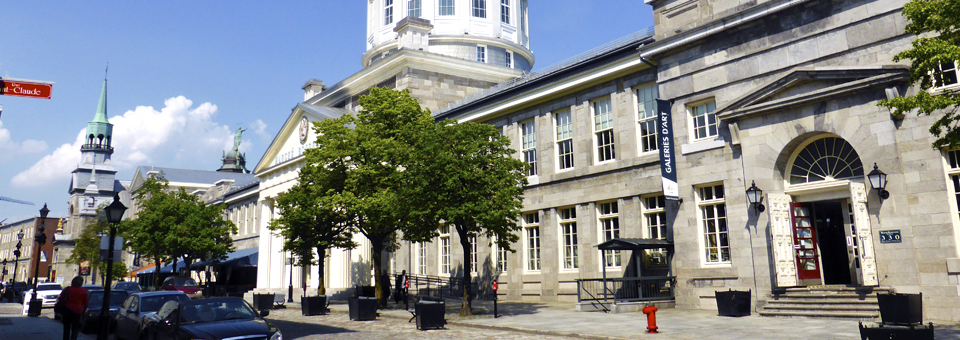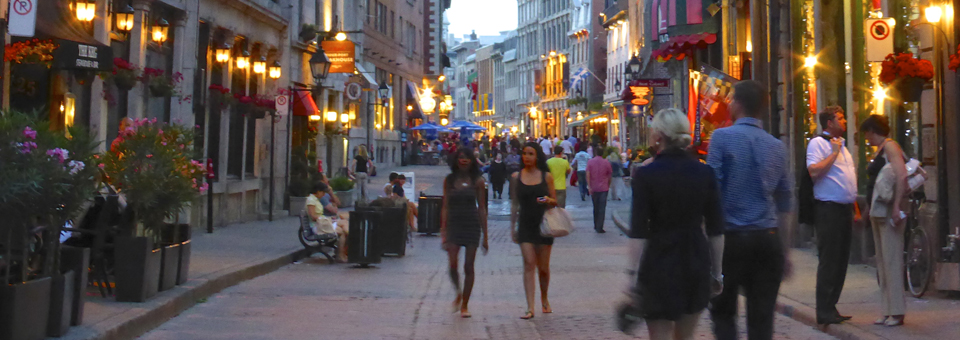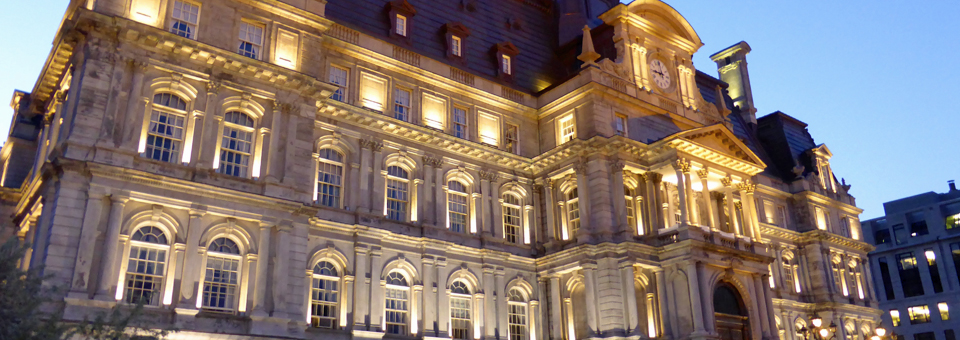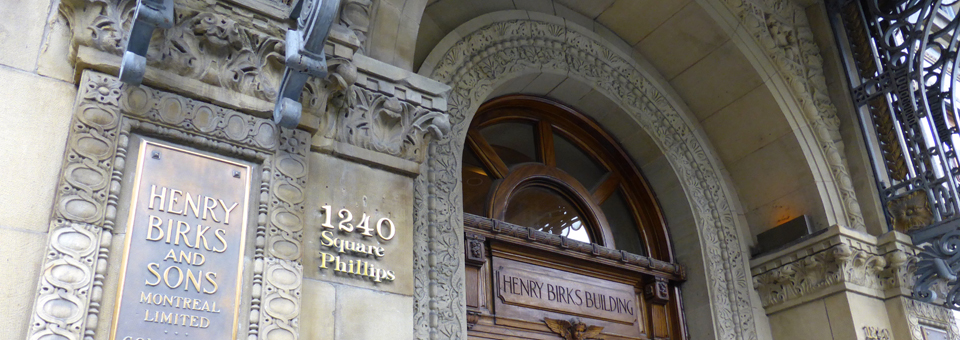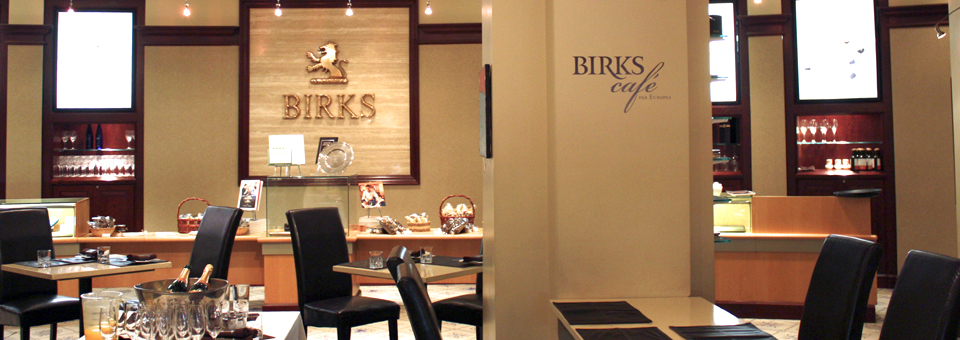Hip and historic Montréal
As we entered Montréal’s Intercontinental Hotel we were already enjoying some of the area’s history. The lobby walls were covered in birch bark and faux fur, allusions to the lumber and fur trading industries that grew this island in the middle of the St. Lawrence River into a booming railway and shipping hub and sophisticated city with Old World charm. The warm and welcoming “Bienvenue!” as we approached the front desk made set the tone for our visit to this French-speaking province.
Our guest room in this towering and turreted hotel overlooked historic Old Montréal and offered us views of Notre Dame Basilica to the left and the Old Port area where, in a few days, we would board the Maasdam straight ahead. Across the river were two remnants of Expo 67, the 1967 World’s Fair. The environment museum Biosphère is in the geodesic dome framework of the U.S. pavilion and Habitat 67, the innovative affordable housing development, is now an upscale apartment complex.
The hotel’s Provence-themed restaurant, Osco!, (meaning Bravo!) had plenty of lunch patrons, an indicator of quality that proved true. We chatted with the staff about the adjacent bar, Sarah B, named for Sarah Bernhardt, French star of stage and silent films, who performed in the hotel’s Nordheimer building. Like many other artists of her time, Bernhardt drank absinthe, the anise flavored spirit then thought to enhance creativity. It is served ceremoniously here.
The hotel lobby led to a pedestrian passageway with trendy boutiques and lively cafés, part of a glass-roofed renovated city block that includes the World Trade Centre Montréal, Victorian Age bank and steamship company buildings, and the St. James, renowned hotel of the rich and famous. A portion of this ruelle des Fortifications, the 18th century city walls and lane, has been preserved creating a space for exhibits and receptions.
Touring the city
Since we would be sailing away on our Holland America Canada and New England Discovery cruise just hours after we embarked, we had flown in four days in advance. Montréal is the largest city in Québec, the second largest city in Canada, and the second largest French-speaking city in the world. It is North America’s only UNESCO City of Design for its arts, culture and creativity and offers much to see, do, buy, and eat.
We arrived on a rainy day, but we didn’t need to concern ourselves with this in Montréal.
We decided to postpone strolling the streets of Old Montréal, on one side of this complex, for the sunny days predicted for the rest of our stay and exited in the opposite direction to utilize the city’s network of underground passageways and transport.
Inclement weather is easily eluded, thanks to RESO, (from the French word réseau, for network). It is the largest underground city and pedestrian network in the world and an attraction in itself. The subway system built for the 1967 World’s Fair expanded to twenty miles of pathways, many lined with shops, eateries, and offices. Over a hundred access points now connect to attractions above ground, providing convenient, traffic-free shortcuts, even on a sunny day.
The elegant Golden Square Mile is a prestigious neighborhood of mansions built by moguls of the Golden Age’s banking, fur, timber, railway and shipping industries. We headed there to see the Museum of Fine Arts, one of the best in North America, and the McCord Museum, with collections on the history and culture of Canada.
Historical Montréal
To make the most of our visit, the next day we toured the city with Ruby, one of Montréal’s knowledgable guides, beginning in Old Montréal. She pointed out the lamp posts and gold and red street signs, features that are unique to each neighborhood. We had an overview of the city’s most interesting features, made a few stops, gained valuable insights, and noted places to explore further on our own.
Old Montréal’s centerpiece is Notre Dame Basilica (1823). The interior wood carvings took forty years to complete. The architect was so moved by its beauty he converted to Catholicism. Céline Dion’s wedding was held in the chapel, which has 32 bronze panels representing birth, life, and death.
Guided walks that include the basilica begin across the street at Place d’Armes, a square with architecture that represents key periods of Montréal’s history. Vieux Séminaire de St-Sulpice, Montréal’s oldest building (1684), was built when this was a fur trading center in New France’s Ville-Marie. The pediment and colonnades of the city’s oldest bank, Banque de Montréal (1848), befit the age when was Montréal was the capital of the United Province of Canada and largest city in British North America. There’s a banking museum inside with free admission. Red sandstone was imported from Scotland for Montréal’s distinctive first skyscraper, the eight-story New York Life building (1888). The Golden Age ended with the Great Depression during construction of the 23-story Art Deco Aldred building (1931) began just before the Great Depression. It resembles the Empire State Building, completed the same year.
A monument to city founder Paul de Chomedey, Sieur de Maisonneuve (1612-1676) is on the center of the square. It marks the spot where settlers defeated Iroquois warriors. De Maisonneuve fought the Iroquois chief.
The city’s joie de vivre was in the air as people basked in the sunshine and lively ambience — street performers, artists, vendors, and sidewalk cafes– of Old Montréal’s Place Jacques Cartier.
.Together with the tall monument Nelson’s (Hero of Trafalgar) Column by City Hall, Place Jacques Cartier a popular meeting spot place to spot street performers.
It began as a marketplace in 1804 and is across from the Hôtel de Ville, the elegant City Hall (1878) where DeGaulle gave his “Vive le Québec Libre” speech. If the door is open, you can walk in and see the beautiful Art Deco interior of Italian marble, bronze French chandeliers, and stained glass windows. It was restored after a fire in 1922 destroyed the original interior.
Also across from City Hall, the 18th century Chateau Ramezay, residence of French governors, was captured by the British and invaded by Americans in 1775. Benjamin Franklin visited in a failed attempt to convince the French to join Americans against the British. It’s now a museum with a French-style garden.
Just down rue de Bonsecours is La Maison du Pierre du Calvet, an elegant 18th century greystone home that is now a hotel and restaurant. Calvet, a French Huguenot, met here with Benjamin Franklin in 1775 in support of the American Revolution. Many of the grand antique furnishings, including those in guest rooms, are original to the home.
At the end of the street, Montréal’s oldest chapel has rooftop statues facing the river. Mariners’ hand-carved replicas of sailing ships, offered with prayers for safe passage, hang inside Notre-Dame-de-Bon-Secours, known as “Sailors’ Church”. Artifacts found when someone fell through the basement showed this to be the oldest part of the city. The church’s archaeology museum also features Marguerite Bourgeoys, its founding nun and teacher. Climb the tower for the view of the port and Old Town.
The adjacent Bonsecour Market (1847) has impressive colonnades and a silver dome that was a landmark for sailors. It served as Parliament of United Canada and then as City Hall. Now it’s the place to find original and creative made-in-Québec items like jewelry, clothing, furs, aboriginal art, and leather goods. Visit in April or October for fashion week sales– 75%-85% off.
One block away, Rue St. Paul is the city’s oldest street (1672) and is pedestrian-only in summer. It is lined with shops and restaurants and has one of the highest concentrations of art galleries in Canada.
Ruby noted the red signs identifying shops of Montréal fashion designers. She pointed out some of her favorite shops are Ambre, on Rue Paul, for the latest Montréal and international fashions and Boutique Sandrini, on Rue Notre-Dame, for shoes. Old Montréal is not just for tourists.
We spotted a movie in the making and preparations for two of the nearly 100 festivals held each year. In Montréal, admission is free to outdoor events on city property and to heritage site buildings.
Roger and I returned to Old Montréal after dark when the architectural gems–including City Hall, the Basilica and Bonsecours Market– are enhanced with illumination. There’s an evening sound show at Notre-Dame that should not be missed.
Flavors of Montréal
“Montréalers won’t be seen sipping coffee as they walk along the street”, Ruby told us. “Cuisine” she said, “is important, a way of life, whether eating out or cooking. Food is taken seriously. And with over 6000 restaurants to choose from in Montréal–more per capita than anywhere else in North America– if a restaurant doesn’t meet the local standards, it won’t last.”
Ruby should know. She runs culinary tours that sell like hotcakes. She was a wealth of knowledge on where locals eat and shop.
She pointed out favorite places–Olive and Gourmando café-bakery, Chez L’Epicier, The Kitchen Gallery Poisson, Marché du Vieux in Old Montréal, and Boris Bistro, on rue McGill, her favorite terrasse.
For coffee, her favorites are Café Club Social or Café Olympico, in the Mile-End district. For chocolates, Geneviève Granbois is one of the best.
Canada produces 85% of the world’s maple syrup, 90% in the province of Québec. “Visit the museum and try the onsite tastings at Maple Delights. But buy the syrup in a can, not the souvenir bottles that expose it to light”, she advised.
The debate continues on which of two well-known family-run bagel bakeries is best — Fairmount or St. Viateur. Montréal’s dense, sweet bagels, made with egg and honey, are rolled by hand, boiled in honey water, and baked in a wood-fired oven.
Schwartz’s, Montréal’s iconic and oldest deli, has been on St. Laurent, also known as “The Main”, since 1928. Smoked meats are made daily from the original recipe.
For an elegant lunch, brunch, or afternoon tea it’s Birks Café par Europea. It’s on the mezzanine level of Birks, the store built in 1879 that is renowned for fine jewelry and its signature blue box. Sweets–macaroons, nougat, and chocolates, — are packaged to take home.
Montréal has several food markets where you can taste your way through an array of local foods. We visited the largest, the 3 1/2 block Jean-Talon. The number of Vermont license plates seen there is indicative of its allure. It’s a great way to assemble an inexpensive meal of cheeses, meats, and prepared foods or to find gifts and souvenirs like mustards, Crème de Cassis, ice cider or black pepper with crystalized maple.
Just strolling along
Later, on our own, with time to explore the street scene, we lingered at terrace restaurants in the trendy Plateau, browsed trend-setting designer fashions along Saint-Denis, and relaxed in Parc du Mont Royale, the only park Frederick Law Olmsted designed outside the United States.
The downtown, with its department stores and shopping complexes, is vibrant by day or night. There’s nine miles of retail and restaurants along Rue Sainte-Catherine, which runs east and west. Simons is a best bet for designer fashions in all price ranges. Rue Crescent below Sainte-Catherine is the place to find designer boutiques and haute couture.
The Quartier des Spectacles is a cornucopia of arts and entertainment. The two-hour walking tour is a good way to see all it has to offer. Balmoral, a bisto on Sainte-Catherine Street West, was a great choice for dinner. Jazz bands perform Thursday through Saturday from 9 pm.
Pointe-à-Callière, by the cruise port, named for the governor of New France, is Montréal’s Museum of Archaeology and History. It was built above the excavations of the fort and Ville-Marie, founded in 1642 and connects to the Old Customs House where Europeans traded with Amerindians. L’Arrivage, the glass-walled restaurant on the second floor, overlooks the river and port and has delectable reasonably-priced lunch specials.
Montréal was once the most important grain port in the world. In the 1970s the Old Port’s grain elevators were removed to create what is now a popular pedestrian-only waterfront park. Walk along the riverside path to the Lachine Canal and if you have time, and continue about two miles to reach the Atwater Market.
For the classic experience, take a half-hour calèche tour around Old Montréal. These horse-drawn carriage can accommodate up to five passengers, and are found by the port.
Money-saving tips
The 3-day Montréal Museums Pass includes museums and transport–bus, subway and the airport shuttle. It’s a great value. One and three day transport passes are also available.
Experience the pulse of the city for the price of a ticket on the #55 bus along the city’s main artery, Boulevard Saint-Laurent. It passes through a variety of neighborhoods known for architectural, cultural and culinary diversity. Once the dividing line between the French and English districts, side streets are designated east or west with numbers starting from “The Main”. Free downloadable mp3 files and a PDF map audio guide, 10 Moments on the Main are found at http://www.mainaudioguide.ca
For more information see http://www.tourisme-montreal.org

